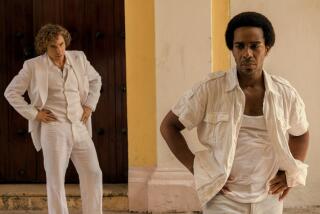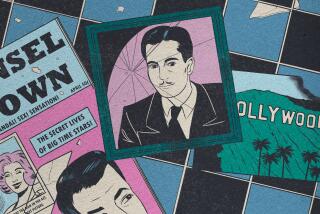Nixonâs Legacy: In Politics, Image Is Everything
Resolute and plain-spoken, Gen. Wesley Clark buoyed Democratic hopes last month by seeming to embody that cardinal but elusive quality: authenticity. Yet suddenly Clark is being depicted as anything but authentic -- as a creation of hack handlers, a latecomer to the party and an ideological chameleon who praised George W. Bush in 2001 and, even worse, once voted for that villain of liberal demonology, Richard Nixon.
Clarkâs change of fortune, even if temporary, shows once more that the dominant subtext of the 2004 campaign has become the search for the authentic.
Howard Deanâs surge stems less from his dovishness than from his John McCain-like straight talk. John Kerry is struggling to beat the perception that he lacks spontaneity. George Bush faces troubles as his public image mutates from that of an unpretentious Texan with an intuitive morality to that of a small-timer beguiled by Machiavellian aides.
The public hunger for authenticity marks the culmination of a long-brewing backlash against our image-drenched, spin-ridden political culture.
The story of how this culture developed is complex, but it can be glimpsed by returning to the figure whose specter again shadows our politics: Nixon.
When Nixon first ran for office in 1946, Americans were, relatively speaking, naive about the use of communications media in the service of image-making. Most understood that politics entailed a measure of posturing, but they generally agreed that their democracy functioned well, with citizens rationally assessing candidates and choosing freely among them.
TV remained a novelty even after that. Into the 1950s, the Democratsâ high-minded standard-bearer, Adlai Stevenson, claimed he never watched it and resisted running ads because he thought that to hawk candidates like âIvory Soap versus Palmoliveâ insulted peopleâs intelligence.
But Nixon -- who came from California, where Hollywoodâs influence and the rise of professional consultants first made âimageâ central to campaigns -- embraced the new techniques of TV and public relations. Nixonâs original consigliere, Murray Chotiner, learned his craft from Clem Whitaker and Leone Baxter, who all but invented modern consulting.
It was Nixonâs television performance in his Checkers speech that saved his place as Dwight Eisenhowerâs running mate in 1952. Under fire that fall for keeping a secret expense fund, Nixon persuaded Ike to let him give a nationally broadcast speech to defend himself. He spoke to the largest audience ever, about 60 million viewers.
In a historic piece of image-craft, Nixon talked earnestly about his onerous childhood and his struggles upon returning from the Navy -- and adorned his speech with folksy touches about his wifeâs cloth coat and his daughtersâ cocker spaniel. So effective was his self-portrait that telegrams flooded in to the studio praising his sincerity, forcing Eisenhower to retain him.
Only a handful of liberal critics dissented, warning that Nixon was using insidious new techniques to misrepresent himself -- and endanger democracy.
But Nixon innovated further. In the decades that followed, he recruited aides from public relations (William Safire), advertising (H.R. Haldeman) and television (Roger Ailes). In 1968, he won the presidency as a âNew Nixon,â through a strategy designed to control his image. When journalist Joe McGinniss detailed this strategy the next year in âThe Selling of the President,â shamefaced reporters vowed to get wise to such manipulation.
âFrom that moment on, we had emerged from the Garden of Eden,â ABCâs Ted Koppel, a campaign reporter in 1968, later recalled.
But Nixon kept at it. Once, the president told Haldeman to find an advisor who could coach him on âhow I should stand, where the cameras will be,â even âwhether I should [hold] the phone with my right hand or my left hand.â Given âthe millions of dollars that go into one lousy 30-second spot advertising deodorant,â he argued, his own image should receive at least as much care.
Yet despite these efforts, Nixon often found himself unable to impose his self-portraits on the electorate. Like the sorcererâs apprentice, he saw his trickery boomerang.
Famously, Nixon once set out to get photographers to shoot him as they had John Kennedy -- debonair and graceful while strolling on the beach. But when Nixon emerged for his seaside shoot, he stalked the sands in trousers and wing tips -- seeming not Kennedy-esque but only like a man straining to seem Kennedy-esque.
Through such failures as well as through his successes, Nixon alerted Americans to the central role of artifice in politics. Such moments gave rise to endless speculation about the ârealâ Nixon, in such books as âIn Search of Nixon,â âThe Real Nixonâ and âThe Man Behind the Mask.â
Ultimately, Nixon came to be seen, in Garry Willsâ phrase, as âthe least âauthenticâ man alive.â
The release of the White House tapes in 1974 doomed Nixon not just because they confirmed his complicity in crimes but also because they showed his die-hard supporters a foul side of the president they hadnât believed existed.
Since Nixon, we have grown wise to the sleights of modern politics -- and politicians have reacted by devising craftier methods.
In the upward spiral of sophistication, the authentic has seemed to recede, like the Earth as seen from a space capsule hurtling skyward.
And so -- jaded -- we are inclined to view it all as a meaningless contest of images. The only politicians who manage to excite us tend to be those who offer relief from -- or scorn for -- the image-making culture: McCain, Jesse Ventura, Rudolph Giuliani just after Sept. 11.
Itâs that quality that a Democratic candidate must radiate to win.
In his twilight years, Nixon, stripped of influence over White House policymaking, loved to kibbitz about his successorsâ problems. Once, commenting on George H.W. Bushâs efforts to divert attention from some political troubles, Nixon commented, âWe tried to do what they are trying -- to change the image during Watergate. It didnât work. Too phony.â
It was a lesson that Nixon both learned and helped to impart.
David Greenberg, who teaches history and political science at Yale, is the author of âNixonâs Shadow: The History of an Imageâ (W.W. Norton, 2003).
More to Read
Get the L.A. Times Politics newsletter
Deeply reported insights into legislation, politics and policy from Sacramento, Washington and beyond. In your inbox three times per week.
You may occasionally receive promotional content from the Los Angeles Times.










